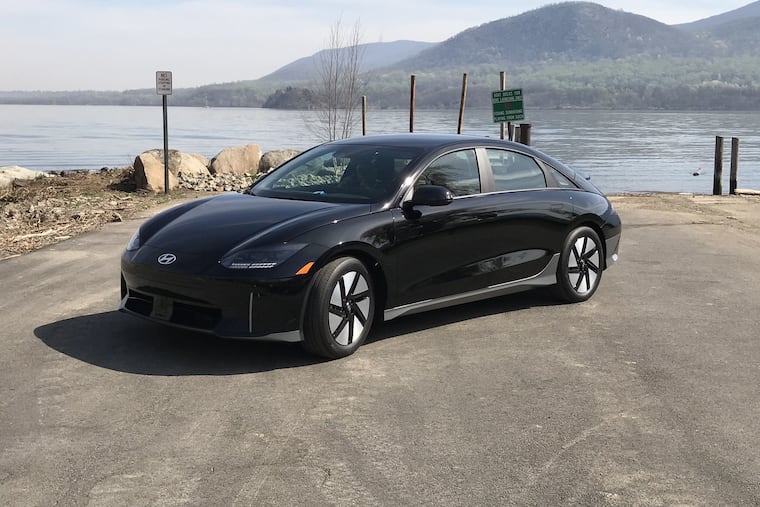2023 Hyundai Ioniq 6 is an EV with range once limited to Tesla buyers
The new EV offers eye-catching styling with comfort, nice road manners, and less range anxiety — and the convenience of keeping a few appliances powered in a storm.

2023 Hyundai Ioniq 6: Stretching the limits of EVs?
Price: $57,425 for a Limited Long Range AWD; $46,825 for an SE Long Range rear-wheel drive.
Marketer’s pitch: “The first-ever, all-electric 2023 Ioniq 6.”
Marketer’s lament: “The 2023 Ioniq 6 has extremely limited inventory,” according to Hyundai’s website, next to a button that asks you to contact the nearest dealer for availability.
Conventional wisdom: Car and Driver likes the “statement-making exterior design, anxiety-reducing driving range, attractive entry pricing,” but not the “heavily digital dashboard” or that it’s “not as cargo friendly as the Ioniq 5 SUV.”
Reality: A range only Tesla buyers could enjoy now coming to a traditional manufacturer near you.
What’s new: The Ioniq 6 sedan continues Hyundai’s foray into the world of EVs, building on the success of the Ioniq 5 SUV and the old Ioniq compact hybrid and EV. The company brought several examples to an event for journalists in the Hudson Valley on April 14, just after being named World Car of the Year at the New York International Auto Show the week before.
The vehicle mimics Mercedes’ AMG E53 sedan profile, with a swoopy low trunk and rear end. The rear features a spoiler and does a fine impression of a Porsche sedan.
Competition: BMW i4, Hyundai Ioniq 5, Mercedes EQE, Tesla Model 3, Tesla Model Y, Polestar 2, Kia EV6.
Up to speed: The acceleration is great, like all the EVs Mr. Driver’s Seat has been testing. Shifting an AWD into Sport mode meant I hardly had to wait before pulling into traffic.
Hyundai claims a zero to 60 mph time of 5.1 seconds for the 320-horsepower model, but between Mr. Driver’s Seat’s traffic squeeze test and a chance to pass uphill on a Highland, N.Y., highway, the Ioniq 6 can compete with the rest of the EVs just fine when equipped with all-wheel drive.
The Ioniq 6′s rear-wheel-drive models have just one motor producing 225 horses. But even under more serene conditions than the AWD passing event, an earlier test on the way to Poughkeepsie left me feeling confident in the RWD’s abilities.
Shiftless: No gears to speak of, naturally. The dial stalk means more console room, and it’s unusual enough to keep you paying attention. Steering-wheel shift paddles control brake regeneration.
On the road: During about 60 miles of driving from West Point north to Poughkeepsie and back, the vehicle experienced plenty of winding roads and lots of Hudson Valley scenery, with plenty of hill-climbing.
The handling remained easy and smooth, the Ioniq 6 sliding through sharp turns and country curves. The floor-mounted batteries definitely help place an emphasis on stability.
Driver’s Seat: The faux leather seats in the upgraded model are on the firm side. The cloth seats in the SE are actually quite nice in the front.
A big touchscreen — the full width of the cockpit, including the gauges — is pretty and easy to follow. Unfortunately, I couldn’t see the whole readout with the steering wheel adjusted for my arms.
Friends and stuff: Headroom and foot room in the Ioniq 6 are cramped, but the legroom is astounding. There’s almost no floor hump to speak of so even the center passenger’s legs should feel comfortable.
The rear seat in faux leather is very plush and squishy, much more so than the front, so people in the back should be able to enjoy the ride. The cloth seats are not so nice in the back. The seats fold down 60/40.
Cargo space is a fairly small 11.2 cubic feet. The trunk lid’s tiny opening could limit larger objects. A hatchback would’ve been a nicer touch here.
A half-cubic-foot of space is available up front as well.
Play some tunes: The controls are what we’ve seen on typical Hyundais but elevated a notch — a row of buttons for map and infotainment selections, with a dial for volume and toggle for tuning.
The 12.3-inch touchscreen is pretty and easy to follow, so having most of the functions there is not a big deal. Sound from the system is pretty clear but not stellar, about a B+ or A-.
Keeping warm and cool: Most HVAC controls are also inside the touchscreen, though there is a small readout for temperature and controls.
A heat-pump system is designed to warm the cabin without draining the battery.
Range: The extended-range models travel as far as 361 miles without charging, according to estimates from the Environmental Protection Agency. Models have varying travel distances, the least of which is still a fairly respectable 240 miles.
Hyundai reports that it can charge within 18 minutes using ultra-high-speed charging.
Like the Ioniq 5, the Ioniq 6 features a two-way charger, so owners can use the car to run appliances when the power goes out or use it for providing electricity while out in the wilderness. A discharge limit can be set so the power will cut out before you use up all your reserves before driving home.
Where it’s built: Asan, South Korea
How it’s built: Consumer Reports has no reliability prediction for the Ioniq 6 yet, but the Ioniq 5 SUV gets a rating of 3 out of 5.
In the end: A long-range, Elon-free EV; what could be better?